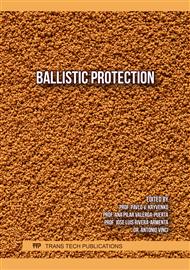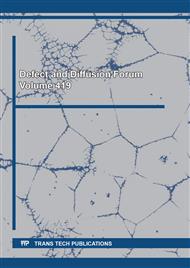[1]
C. Bouvet, S. Rivallant, Damage tolerance of composite structures under low-velocity impact, in: V.V Silberschmidt (Eds), Dynamic Deformation, Damage and Fracture in Composite Materials and Structures, Elsevier, 2016, pp.7-33.
DOI: 10.1016/b978-0-08-100080-9.00002-6
Google Scholar
[2]
S.Z.H. Shah, S. Karuppanan, P.S.M. Megat-Yusoff, Z. Sajid, Impact resistance and damage tolerance of fiber reinforced composites: A review, Composite Structures. 217 (2019) 100-121.
DOI: 10.1016/j.compstruct.2019.03.021
Google Scholar
[3]
M.A. Abtew, F. Boussu, P. Bruniaux, C. Loghin, I. Cristian, Ballistic impact mechanisms – A review on textiles and fibre-reinforced composites impact responses, Composite Structures. 223 (2019) 110966.
DOI: 10.1016/j.compstruct.2019.110966
Google Scholar
[4]
T.D. Karimbaev, CF composite fan rotor blading for perspective engines, Engine. 6 (2011) 1-6.
Google Scholar
[5]
F. Aymerich, F. Dore, P. Priolo, Simulation of multiple delaminations in impacted cross-ply laminates using a finite element model based on cohesive interface elements, Composites Science and Technology. 69 (2009) 1699-1709.
DOI: 10.1016/j.compscitech.2008.10.025
Google Scholar
[6]
S. Heimbs, T. Bergmann, D. Schueler, N. Toso-Pentecôte, High velocity impact on preloaded composite plates, Composite Structures. 111 (2014) 158-168.
DOI: 10.1016/j.compstruct.2013.12.031
Google Scholar
[7]
C. Menna, D. Asprone, G. Caprino, V. Lopresto, A. Prota, Numerical simulation of impact tests on GFRP composite laminates, International Journal of Impact Engineering. 38 (2011) 677-685.
DOI: 10.1016/j.ijimpeng.2011.03.003
Google Scholar
[8]
D. Varas, J.A. Artero-Guerrero, J. Pernas-Sánchez, J. López-Puente, Analysis of high velocity impacts of steel cylinders on thin carbon/epoxy woven laminates, Composite Structures. 95 (2013) 623-629.
DOI: 10.1016/j.compstruct.2012.08.015
Google Scholar
[9]
M. Schwab, H.E. Pettermann, Modelling and simulation of damage and failure in large composite components subjected to impact loads, Composite Structures. 158 (2016) 208-216.
DOI: 10.1016/j.compstruct.2016.09.041
Google Scholar
[10]
M. Schwab, M. Todt, H.E. Pettermann, A multiscale approach for modelling impact on woven composites under consideration of the fabric topology, Journal of Composite Materials. 52 (2018) 2859-2874.
DOI: 10.1177/0021998318755865
Google Scholar
[11]
L.M. Bresciani, A. Manes, A. Ruggiero, G. Iannitti, M. Giglio, Experimental tests and numerical modelling of ballistic impacts against Kevlar 29 plain-woven fabrics with an epoxy matrix: Macrohomogeneous and Meso-heterogeneous approaches, Composites Part B. 88 (2016) 114-130.
DOI: 10.1016/j.compositesb.2015.10.039
Google Scholar
[12]
O.A. Kudryavtsev, M.V. Zhikharev, N.A. Olivenko, Creation and verification of computational models for analysis of the mechanical behaviour of jet engines composite components under high-velocity impact: Main problems and basic recommendations, PNRPU Mechanics Bulletin. 4 (2019) 68-79.
DOI: 10.15593/perm.mech/2019.4.07
Google Scholar
[13]
О.A. Kudryavtsev, A.V. Ignatova, N.A. Olivenko, The influence of thickness on residual flexural strength of composite with low-velocity impact damages: Experimental study, PNRPU Mechanics Bulletin. 3 (2021) 6-11.
Google Scholar
[14]
J.P. Lambert, G.H. Jonas, Towards Standardization in Terminal Ballistics Testing: Velocity Representation, BRL Report No. 1852, Aberdeen Proving Ground, MD: U.S. Army Ballistic Research Laboratories, (1976).
DOI: 10.21236/ada021389
Google Scholar
[15]
O.A. Kudryavtsev, S.B. Sapozhnikov, Yarn-level modelling of woven and unidirectional thermoplastic composite materials under ballistic impact, PNRPU Mechanics Bulletin. 3 (2016) 108-119.
DOI: 10.15593/perm.mech/2016.3.07
Google Scholar
[16]
N.K. Naik, P. Shrirao, B.C.K. Reddy, Ballistic impact behaviour of woven fabric composites: Parametric studies, Materials Science and Engineering A. 412 (2005) 104-116.
DOI: 10.1016/j.msea.2005.08.019
Google Scholar



